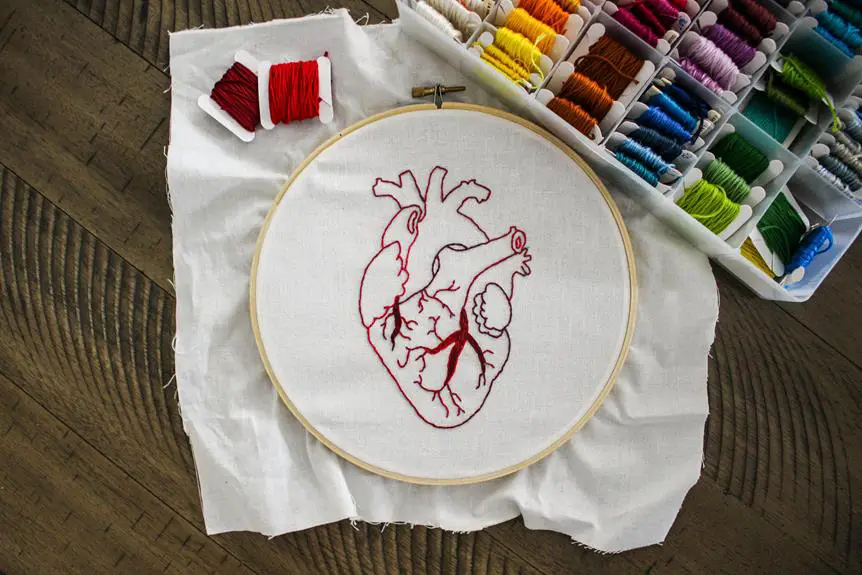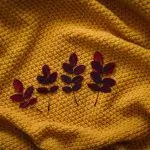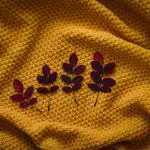When it comes to embroidery, choosing the right fabric is like selecting the perfect canvas for a masterpiece. Different fabrics offer unique textures, weights, and weaves that can greatly impact the outcome of your embroidery.
Understanding which fabric is best for your specific project can elevate your stitching to the next level. Whether it's the crispness of cotton, the natural look of linen, or the smoothness of silk, each fabric brings its own charm to the embroidery process.
By mastering the art of selecting the best fabric for your embroidery, you can ensure that your stitches stand out and your creations truly shine.
Key Takeaways
- Cotton fabric is ideal for intricate designs and offers versatility with different types of embroidery thread.
- Linen fabric adds depth and dimension to designs with its natural texture and allows for precise stitching.
- Aida cloth is suitable for beginners and offers even weave, stability, and visibility for cross-stitch techniques.
- Evenweave fabric provides consistent stitch sizes and ease in creating intricate designs, with options for different embroidery styles.
Cotton Fabric
Cotton fabric is ideal for embroidery due to its smooth and sturdy texture, making it easier to create intricate designs. When selecting cotton fabric for your embroidery project, it's crucial to consider the thread choices. The type of embroidery thread you choose can significantly impact the final outcome of your design.
Cotton fabric pairs well with various embroidery thread types, including stranded cotton floss, perle cotton, and cotton floche. Each type offers unique qualities that can enhance the appearance of your embroidery on cotton fabric.
Stranded cotton floss is a popular choice for cotton fabric embroidery due to its versatility and availability in a wide range of colors. It consists of six strands that can be separated to achieve different thicknesses, allowing for detailed and delicate stitching on cotton fabric.
Perle cotton, on the other hand, is a non-divisible thread that adds a textured dimension to embroidery on cotton fabric. It comes in different weights, with size 5 being ideal for bold and visible stitches, while size 8 works well for finer details.
Additionally, cotton floche, a softly twisted thread, provides a smooth and lustrous finish, making it suitable for creating a satin-stitch effect on cotton fabric.
Selecting the right embroidery thread for your cotton fabric project is essential for achieving the desired results.
Linen Fabric
When it comes to embroidery, linen fabric offers a unique natural texture that adds depth and dimension to your designs. Its breathability and durability make it an ideal choice for creating long-lasting and beautifully detailed embroidery pieces.
The smooth, even surface of linen fabric provides a perfect canvas for intricate stitches and delicate threadwork.
Linen's Natural Texture
When choosing a fabric for your embroidery project, linen fabric stands out due to its natural texture, which provides a unique surface for intricate stitching. Linen, made from natural fibers, offers a distinct texture that enhances the overall look of needlework.
Here are some key points to consider about linen's natural texture:
- Linen's slightly uneven texture adds depth and dimension to embroidery, creating a visually appealing effect.
- The fabric's natural stiffness makes it easier to work with, allowing for precise stitching and detailed designs.
- Linen's inherent strength and durability ensure that your embroidery will remain intact for years to come.
- The fabric's ability to hold creases and folds adds a three-dimensional quality to your embroidery work.
- Linen's natural color variations can complement different embroidery thread shades, enhancing the overall aesthetic of your project.
Linen's Breathability and Durability
To fully understand the benefits of linen fabric for embroidery, consider its breathability and durability.
Linen is highly breathable, making it ideal for embroidery, as it allows for proper ventilation and moisture absorption. This natural moisture-wicking property ensures that the fabric remains comfortable to wear, even when adorned with intricate embroidery.
Moreover, linen is renowned for its exceptional durability, making it a practical choice for embroidered garments that are meant to withstand regular use.
Beyond its suitability for embroidery, linen also boasts a minimal environmental impact, as it's a renewable resource that requires minimal water and pesticides for cultivation.
Additionally, linen's versatility in the fashion industry further enhances its appeal for embroidery, as it can be tailored into various garment types, from casual wear to formal attire.
Linen's Ideal for Embroidery
Linen fabric's breathability and durability make it a top choice for embroidery, allowing you to create long-lasting and comfortable pieces. When it comes to linen embroidery techniques, this fabric offers a smooth, even surface that's perfect for intricate stitching.
Additionally, linen's natural fibers provide a sturdy foundation for your embroidery, ensuring that your designs will stand the test of time. When choosing linen thread options for your embroidery projects, consider using a slightly thicker thread to take advantage of the fabric's strength and texture.
The subtle sheen of linen also adds a beautiful dimension to your embroidered pieces, enhancing the overall aesthetic. Overall, linen fabric's qualities make it an ideal canvas for showcasing your embroidery skills.
Aida Cloth
When it comes to embroidery, Aida cloth is a popular choice. It is known for its even weave and easy-to-count squares. Stitching on Aida cloth is a breeze, especially for beginners. If Aida cloth isn't your preferred fabric, there are alternative options to consider for your embroidery projects.
Aida Cloth Benefits
You'll find Aida cloth to be a versatile and popular choice for embroidery projects. Aida cloth offers several benefits that make it ideal for various stitching techniques and custom embroidery designs.
Here are some advantages to using Aida cloth for your embroidery projects:
- Even Weave: Aida cloth's uniform weave makes it easier to create neat and consistent stitches.
- Count Options: Available in different counts, Aida cloth provides flexibility for various design sizes and stitch styles.
- Stability: The stiffness of Aida cloth makes it easier to handle and prevents distortion while stitching.
- Visibility: The visible grid of Aida cloth assists in counting stitches accurately, especially for cross-stitch patterns.
- Durability: Aida cloth is strong and holds up well to frequent handling and stitching, ensuring the longevity of your embroidered piece.
Stitching on Aida
To stitch on Aida cloth, select a needle appropriate for the fabric's count and begin by securing the thread on the backside of the fabric.
When using Aida cloth for embroidery, cross stitch techniques are commonly employed due to the fabric's even weave. This allows for easy counting and consistent stitch sizes.
To enhance your stitching on Aida, consider using an embroidery hoop to maintain proper needlework tension, preventing puckering and ensuring a smooth finished piece.
Additionally, Aida cloth offers a wide range of color variations, providing ample choices for your embroidery projects. Experiment with different thread colors and textures to create unique and vibrant designs on this versatile fabric.
With the right tools and techniques, Aida cloth can be a fantastic choice for your embroidery endeavors.
Aida Cloth Alternatives
Consider cotton evenweave fabric as an alternative to Aida cloth for your embroidery projects. This fabric has a smooth texture and an even weave, making it a great choice for intricate stitching. It provides a solid base for your embroidery work and is available in various thread counts to suit different project needs.
When exploring alternatives to Aida cloth, you may also want to consider the following options:
- Linen fabric: Offers a natural and rustic look for embroidery projects.
- Waste canvas: Suitable for adding embroidery to non-traditional surfaces such as clothing or bags.
- Embroidery on denim: Adds a trendy and unique touch to your designs.
- Embroidery on velvet: Creates luxurious and elegant embroidered pieces.
These alternatives provide diverse textures and visual appeal, allowing you to explore different creative possibilities.
Evenweave Fabric
When selecting fabric for embroidery, it's important to understand the characteristics of evenweave fabric. Evenweave fabric, as the name suggests, has an evenly woven structure with the same number of horizontal and vertical threads per inch, making it ideal for precise stitching.
The benefits of using evenweave fabric for embroidery are numerous. Its uniform weave allows for consistent stitch sizes and helps in creating intricate designs with ease. Moreover, evenweave fabric is available in various thread counts, offering options for different embroidery styles and preferences.
When working with evenweave fabric, it's essential to employ the appropriate stitching techniques. Due to its evenly woven nature, traditional embroidery stitches like the cross-stitch, satin stitch, and backstitch can be executed neatly and symmetrically. The consistent fabric structure also facilitates the use of specialty stitches, such as the eyelet stitch and Algerian eye stitch, resulting in stunning and uniform embellishments.
Silk Fabric
Silk fabric offers a luxurious and lustrous surface for creating exquisite embroidered designs. When it comes to silk embroidery, the fabric's smooth texture and natural sheen make it an ideal choice for showcasing intricate stitching and delicate details. Here are some key points to consider when working with silk fabric for embroidery:
- Silk Thread Choices: Selecting the right silk thread is crucial for achieving stunning results. Mulberry silk threads are highly recommended for their strength, sheen, and color retention. They come in a wide range of vibrant hues, allowing you to add depth and dimension to your embroidered pieces.
- Fabric Preparation: Prior to starting your embroidery project, it's essential to prepare the silk fabric properly. This may involve pre-washing the fabric to remove any sizing or impurities, ensuring that it's clean and ready for stitching.
- Needle Selection: When working with silk fabric, opt for fine, sharp needles to minimize any damage to the delicate fibers. Choosing the appropriate needle size will help you create smooth and precise stitches without causing unnecessary strain on the fabric.
- Handling and Care: Silk fabric requires gentle handling to avoid snags or pulls. It's important to store the fabric in a clean, dry environment and handle it with care to preserve its pristine condition throughout the embroidery process.
- Embroidery Techniques: Silk fabric lends itself well to a variety of embroidery techniques, including satin stitch, French knots, and delicate floral motifs. Experimenting with different stitches and patterns can showcase the fabric's natural luster and drape, resulting in stunning embroidered masterpieces.
When it comes to silk embroidery, the fabric's luxurious qualities and the right thread choices can elevate your needlework to a whole new level, allowing you to create heirloom-quality pieces that exude elegance and sophistication.
Wool Fabric
For embroidery, wool fabric provides a warm and textured surface that allows for intricate stitching and unique design opportunities. Wool is a versatile fabric that can be used for a wide range of embroidery techniques, making it a popular choice among embroidery enthusiasts. Its natural fibers create a slightly uneven surface, adding depth and dimension to embroidered designs.
| Wool Fabric | Characteristics | Suitable Embroidery Techniques |
|---|---|---|
| Wool Flannel | Soft, warm, and slightly fuzzy | Crewel embroidery, appliqué |
| Wool Felt | Dense and sturdy | Blanket stitch, cutwork |
| Wool Crepe | Textured and drapey | Stumpwork, raised embroidery |
| Wool Gabardine | Smooth and durable | Surface embroidery, smocking |
| Wool Tweed | Speckled and rough | Cross-stitch, needle painting |
Wool fabric's unique properties make it ideal for various embroidery techniques. Whether you're creating intricate floral patterns with crewel embroidery on wool flannel or adding texture to your designs with stumpwork on wool crepe, wool fabric offers a rich and tactile canvas for your embroidery projects. Experiment with different types of wool fabric to discover the endless possibilities for creating stunning, textured embroidery pieces.
Blended Fabrics
Exploring blended fabrics for embroidery, you'll find a diverse range of textures and characteristics that enhance the versatility of your stitching techniques. Blended fabrics, which are made by combining two or more different types of fibers, offer several benefits for embroidery enthusiasts.
When considering embroidery on blended fabric, keep in mind the following:
- Enhanced Durability: Blended fabrics often exhibit improved strength and durability compared to single-fiber fabrics, making them suitable for intricate embroidery work that requires stability.
- Color Retention: Blended fabrics tend to hold dyes well, ensuring that the vibrant colors used in embroidery remain true and vivid over time.
- Versatility: With a combination of fibers, blended fabrics can offer a wider range of textures and finishes, allowing for diverse and creative embroidery designs.
- Wrinkle Resistance: Many blended fabrics are less prone to wrinkling, which can be advantageous when embroidering garments or items that may require frequent washing.
- Cost-Effectiveness: Blended fabrics can provide a balance between quality and affordability, making them a practical choice for various embroidery projects.
Frequently Asked Questions
Can Embroidery Be Done on Stretchy Fabrics Like Spandex or Jersey?
Yes, embroidery can be done on stretchy fabrics like spandex or jersey. When choosing a fabric for embroidery, consider the stretchiness and weight. Different stitches may work better on certain fabrics, so test out your options.
Are There Specific Fabrics That Are Best for Different Types of Embroidery Stitches?
For different embroidery stitches, specific fabrics work best. Consider the weight, weave, and texture of the fabric to match the embroidery style. Certain stitches, like satin or French knots, may require a sturdier fabric to hold their shape.
Can You Use Embroidery on Fabric That Has a Print or Pattern Already on It?
Yes, you can use embroidery on fabric that has a print or pattern already on it. When using printed fabric, choose suitable stitches that complement the pattern. Just ensure the fabric isn't too stretchy for a smooth embroidery process.
Are There Any Special Considerations for Embroidering on Dark-Colored Fabrics?
When embroidering on dark colored fabrics, it's important to consider fabric stretchiness and embroidery stitch compatibility. Patterned fabric embroidery can be stunning, but for clothing and accessories, choose durable, tightly woven fabrics for best results.
What Are the Best Fabrics for Embroidery That Will Be Used for Clothing or Accessories?
For embroidery techniques, the best fabrics for clothing or accessories are natural fibers like cotton, linen, or silk. They offer excellent fabric selection for embroidery durability and a smooth surface for intricate stitching.
- How Does Ring Spun Cotton Affect Garment Fit and Shape Retention? - August 13, 2024
- What Are the Challenges in Producing Ring Spun Cotton? - August 13, 2024
- Is Ring Spun Cotton Suitable for Plus-Size Clothing? - August 13, 2024




